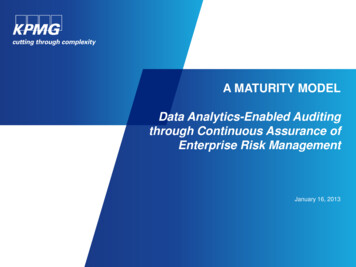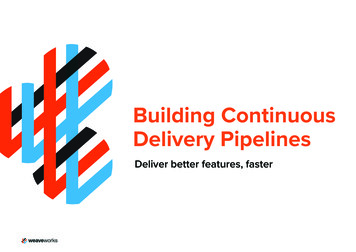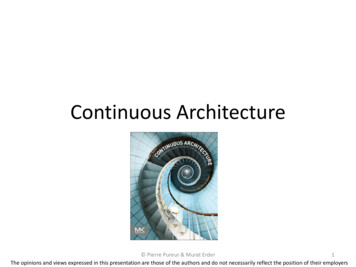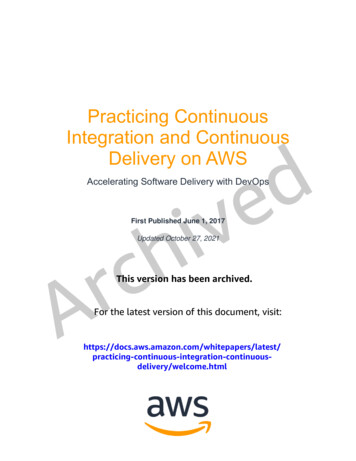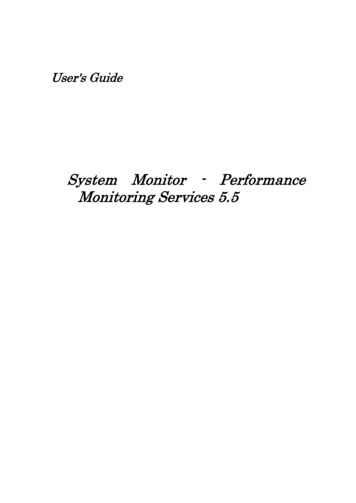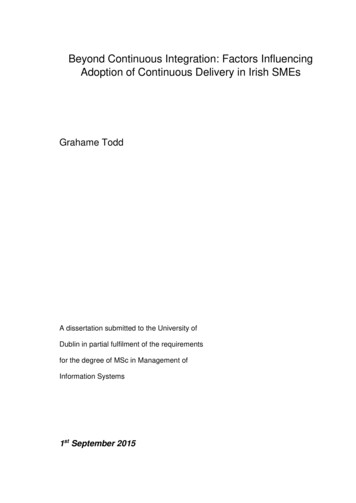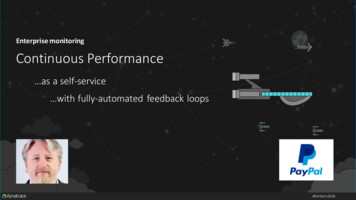
Transcription
Enterprise monitoringContinuous Performance as a self-service with fully-automated feedback loops#Perform2018
Continuous Integration“ is the practice, in software engineering, of merging all developerworking copies with a shared mainline several times a day.”Pragmatically: autonomous, pre-scheduled build and deploy for DEV and QA inclusive of an automated “build verification test” is rarely autonomous or unattendedImplementation basics: powered-by Visual Studio, Jenkins, Bamboo integrated with code version control and config mgmt originated with eXP and test driven development (TDD)
Continuous Delivery“the practice of continuous delivery further extends CI by making surethe software checked in on the mainline is always in a state that canbe deployed to users and makes the actual deployment process veryrapid.“Pragmatically: automates release management between QA and PROD highly automated and orchestrated deploy/roll-back automated tests validate the code is “release ready” requires more rigorous, elaborate checkingImplementation basics: powered-by Puppet, Chef, VMWare, Home-grown defined as a part of eXP – refined by Jez Humble/Dave Farley
Continuous Performance LifecycleDevelopment(very unreal world)Performance TestingPracticeProductionPerformance(a.k.a. “the Real World”)
Continuous Performance LifecycleCIDevelopment(very unreal world)CDPerformance TestingPracticeProductionPerformance(a.k.a. “the Real World”)
Promotional FlowDevelopment(very unreal world)Performance TestingPracticeProductionPerformance(a.k.a. “the Real World”)
Promotional FlowsFrom DEV to PERF (via Continuous Integration) Performance regression testing – repeated testing and trendingNew code and app config changesNew applications and integrations to be testedUnit-level performance information dataFrom PERF to OPS (via Continuous Delivery) Validation that a release will meet performance demandPerformance guidance – top ten “worst offenders”Performance threshold update – re-configure APM monitorsPerformance test report generated and published to RM
Feedback FlowDevelopment(very unreal world)Performance TestingPracticeProductionPerformance(a.k.a. “the Real World”)
Feedback FlowFrom OPS - PERF Monitoring performance in PROD, setting new trends/thresholdsSynchronizing test simulation with PROD (volume, mix, throughput)Synchronizing thresholds with PROD (resources, app metrics)Production issue repro/remediation – performance escalationPERF- DEV Performance defects – bottlenecks and proposed remediationEarly Performance Testing – unit-level performance resultsStrategic performance measurements – for architectureSystem future estimations – for PM’s and Biz
Continuous Performance FlowsCIDevelopment(very unreal world)CDPerformanceTesting and EngineeringPracticesProductionPerformance(a.k.a. “the Real World”)
Out-of-Flow Continuous PerformanceDevelopmentCI - Testing - CD(very unreal world)ProductionPerformance(a.k.a. “the Real World”)Performance TestingPractice
Performance DecisionsHow do we make decisions about performance? We make decisions based on the information we have – not with theinformation we wish we had We make decision based on our understanding of the information we have –with our default perspective If the information is limited – the decision will be limited If the information isn’t timely – our decision will be inaccurate If we don’t know what came before – we can’t estimate what will come nextWith every sacrifice and limitation, our value decreases.
Performance DecisionsWe can analyze performance at each point of the flow: Every time we move code along the promotional flowEvery time we accept feedback about performanceEvery time we choose to reverse our decision to promoteEvery time we decide to repeat a testEvery time we decide to log a bugEvery time we change our plans according to new informationIf the performance information is not timely: A wrong decision may delay competitive features for the biz A right decision may come too late to avoid disaster Any decision can and should be revisited in the face of change
Continuous Performance Tooling#Perform2018
Continuous Performance ToolingThere are 3 primary “new tools” toadd to your typical performancetesting effort/team: tools for unattended automation tools for datatrending/visualization tools for test notifications
DEMONSTRATION: UNATTENDED AUTOMATION WITH RUNDECK
REVIEW: UNATTENDED AUTOMATION WITH RUNDECK Using Rundeck we achieve the following: Separation of jobs for scripts, scenarios, utilities Ability to schedule automatic start Ability to “halt the automation” (e.g. a hold button) Ability to run a script or scenario manually Job status notification Job activity history
DEMONSTRATION: JMETER CUSTOMIZATIONS
REVIEW: JMETER CUSTOMIZATIONS By Extending the testing tool we achieve the following: Portability to different environments Adaptability to serve multiple, different scenarios Improved code-reuse and collaboration Results extensibility to external data stores
DEMONSTRATION: PERFORMANCE VISUALIZATION
DEMONSTRATION: PERFORMANCE VISUALIZATION
DEMONSTRATION: PERFORMANCE VISUALIZATION
REVIEW: PERFORMANCE VISUALIZATIONSWe reviewed the following in Grafana and Dynatrace: Connection to a time-series database (e.g. InfluxDB) Separation of dashboards by app Combined dashboard for all traffic Drill-down capability: digging deeper into metrics Consistent coloring, helps to remember metrics Advanced features for viewing timeframe and refresh Advanced metrics querying, granularity and aggregation
DEMONSTRATION: NOTIFICATION AND COMMUNICATION
DEMONSTRATION: NOTIFICATION AND COMMUNICATION
REVIEW: NOTIFICATION AND COMMUNICATIONWe reviewed the following in Slack: Individual channels for apps/teams Combined channels for all traffic Real-time notification of test events Bot-identity .making the automation more personableWe reviewed the following in JIRA Comments: Automatic summary comment from the test results Links to drill-down into the results tools/dashboards
OTHER TOOLSConsider a few other things you might need: Managing test data state continuously (flashbacks/restore) Service Virtualization - simulating external systems Support for different load generation tools Application log analysis – grepping for exceptions/errors Storage for all the results data can get HUGE over-time
WHERE TO START.#Perform2018
WHERE TO START DevOps Handbook Part 2 “Where to Start” Greenfield vs. “Brownfield” Systems of Record vs. Engagement Sympathetic and Innovative Teams Expanding DevOps/Continuous-ness
Consider the following questions at the start: are your stakeholders/customers ready for continuous feedback? Howwill they react? Will they value faster feedback? do you use information radiators/visual mediums to deliver theperformance trends visually? do you have notification systems (email, chatops, Slack) forcommunication to results and trends? are your test environments configured to support unattended, non-stoptest runs? do you have the tools and licenses ready for more executions?
GRADUAL ADOPTION:Slowly introduce continuous performance: Consider just 1 day a week to run non-stop testing Consider a team that already dominates your schedule It takes time for people to adjust to frequent feedback, how toreact and behave You will also receive feedback on your tooling/visuals – taketime to improve
Start with Dev CIDevelopment(very unreal world)Performance TestingPractice
then add ProductionCIDevelopment(very unreal world)CDPerformance TestingPracticeProductionPerformance(a.k.a. “the Real World”)
SUMMARY Performance can be measured continuously Know the difference: promotion and feedback One-time performance tests vs. repeated testing Absolute vs. relative measurements Performance decisions are made continuously Decisions and analysis are based on data Find ways to capture metrics across the lifecycle
Mark Tomlinson, .blogspot.com @mark on taskPerfBytes Podcast: @perfbytesThank you
From DEV to PERF (via Continuous Integration) Performance regression testing -repeated testing and trending New code and app config changes New applications and integrations to be tested Unit-level performance information data From PERF to OPS (via Continuous Delivery) Validation that a release will meet performance demand

